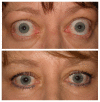Thyroid Eye Disease
Abstract
Thyroid eye disease, although rare, is the most common inflammatory orbital disorder and is associated with autoimmune thyroid dysfunction. It is a progressive disorder with symptoms and signs that may cause significant facial disfigurement, visual disability, but rarely blindness. We will review the diagnostic criteria, immunologic basis, clinical course, and medical and surgical treatments for thyroid eye disease. Recent developments in the use of biologic agents to treat this disorder appear to be changing its progression curve and offer the first specific and preventative therapeutic options.
Copyright 2022 by the Missouri State Medical Association.
Conflict of interest statement
Disclosure MCS is a Consultant/Advisor to Horizon Therapeutics.
Figures






References
-
- Bartley GB, Gorman CA. Diagnostic criteria for Graves’ ophthalmopathy. Am J Ophthalmol. 1995 Jun;119(6):792–5. - PubMed
-
- Li Z, Cestari DM, Fortin E. Thyroid eye disease: what is new to know? Curr Opin Ophthalmol. 2018 Nov;29(6):528–534. - PubMed
-
- Lazarus JH. Epidemiology of Graves’ orbitopathy (GO) and relationship with thyroid disease. Best Pract Res Clin Endocrinol Metab. 2012 Jun;26(3):273–9. - PubMed
MeSH terms
Substances
LinkOut - more resources
Full Text Sources
